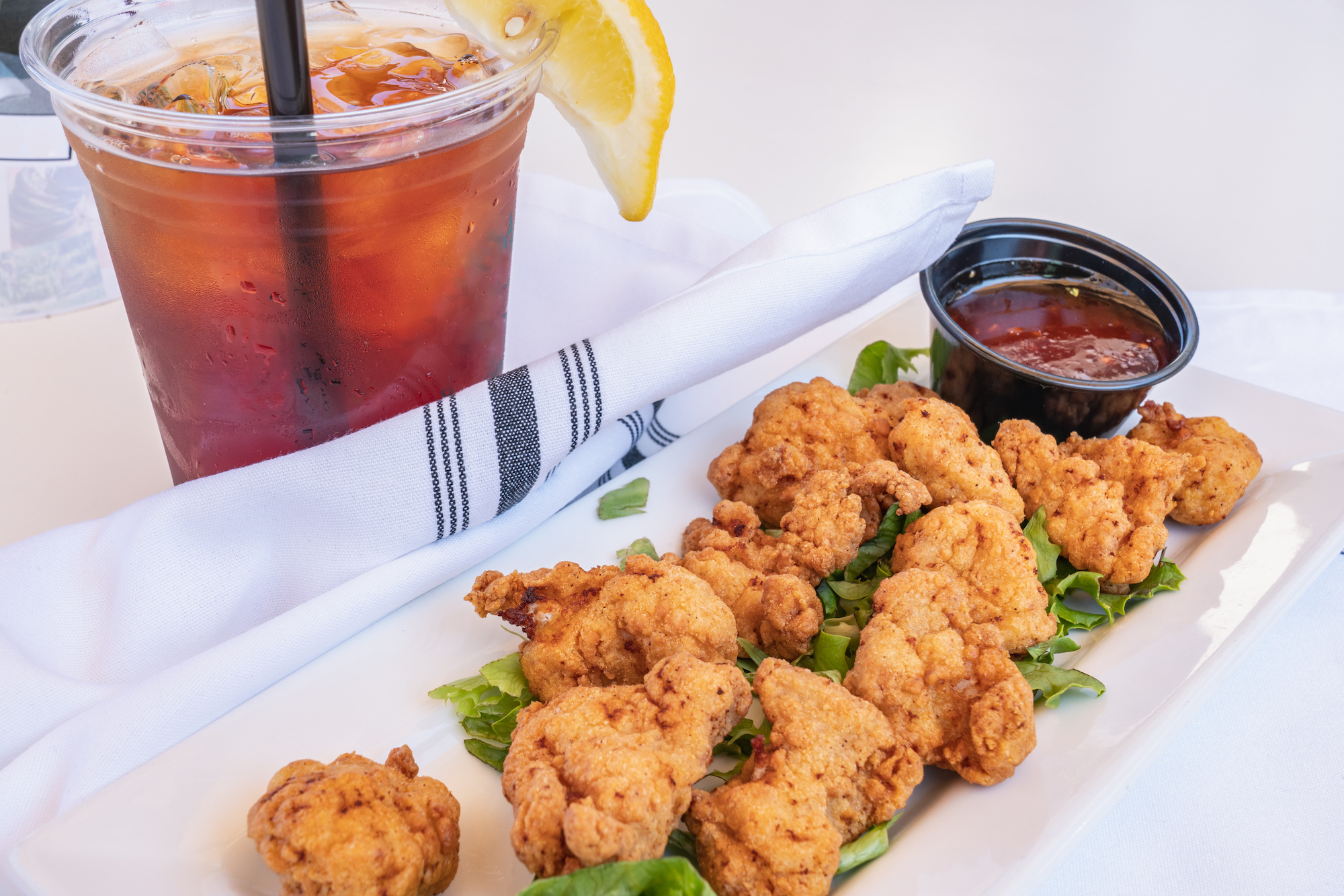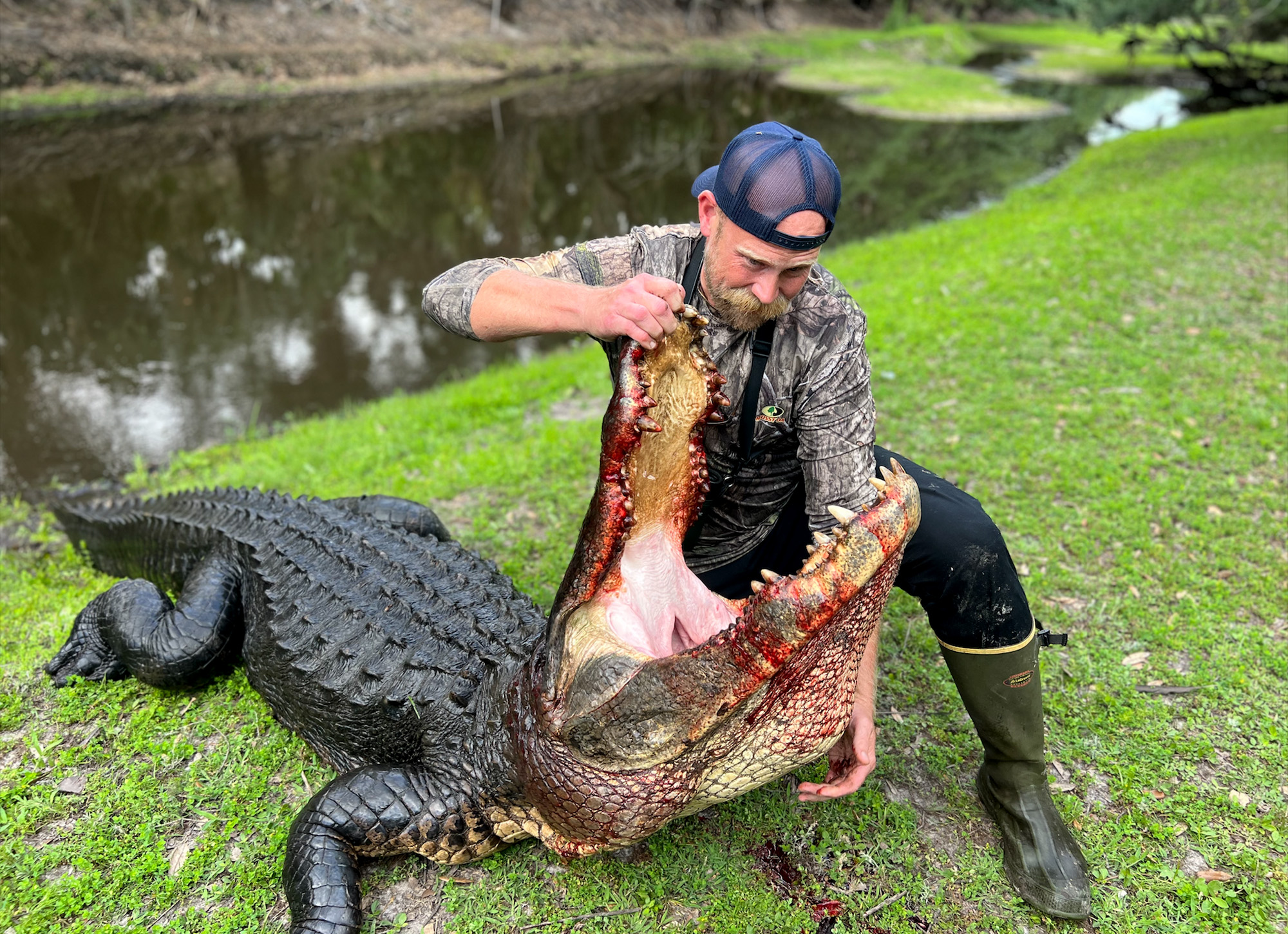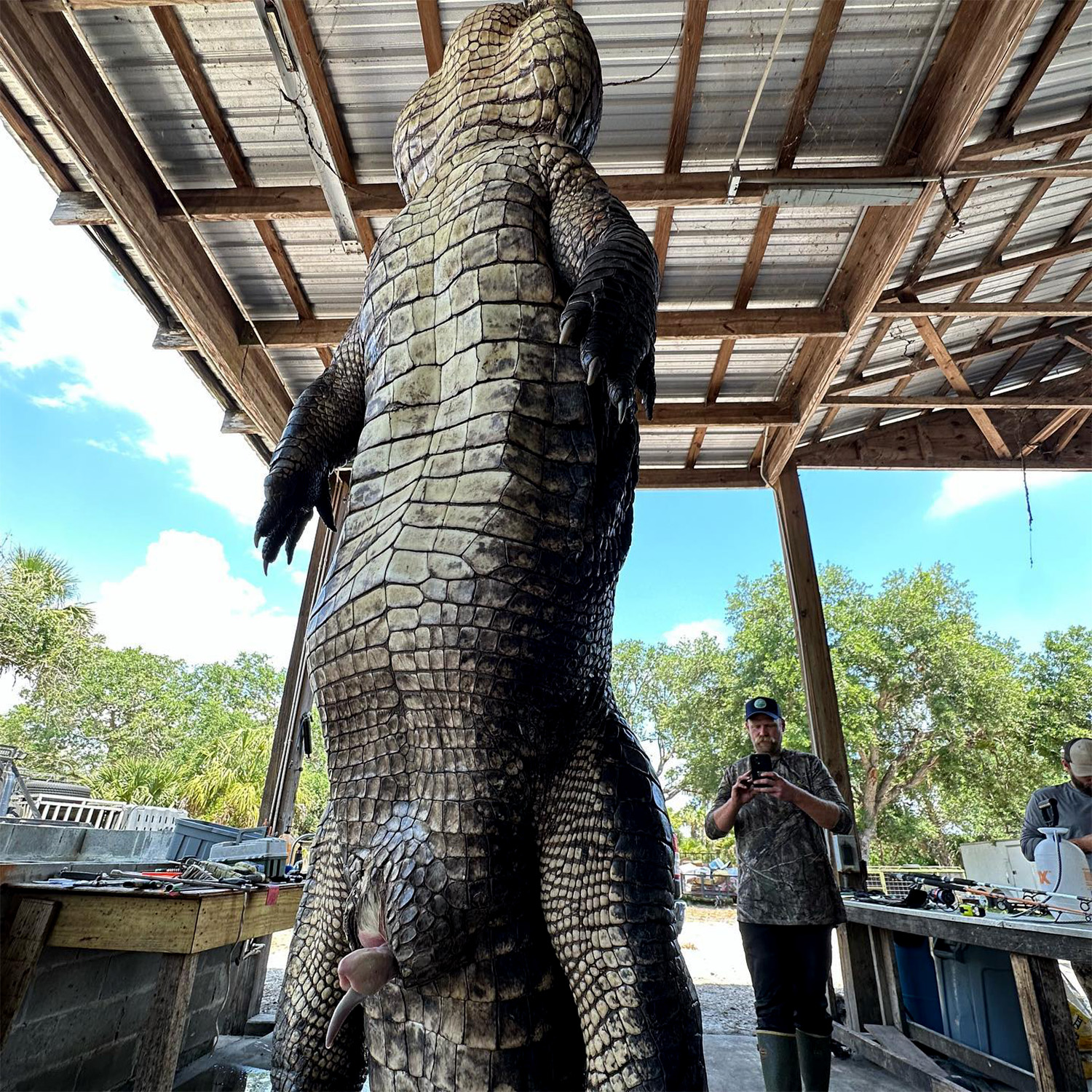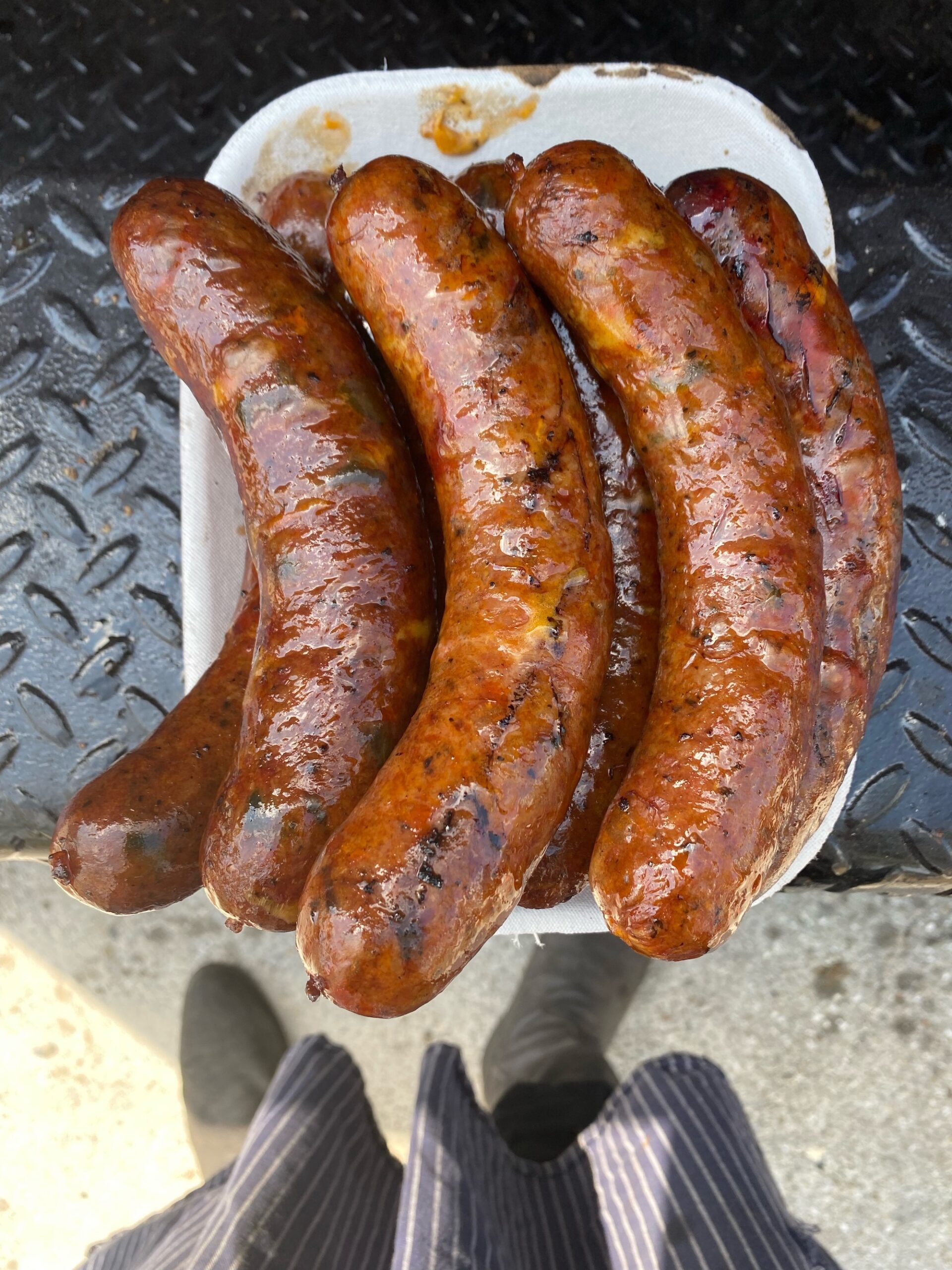How to Cook a 12-Foot Gator: Alligator Recipes from a Florida Chef
The alligator recipe book doesn't end with fried gator tail

Of all the critters in the South, the American alligator might be the most intimidating to clean and cook. Most wild game cooks living in bayou country know their way around squirrels, frogs, deer, snakes, hogs, turtles, and even giant swamp rats. But give them a 12-foot bull gator, and some might hesitate before taking a knife to it.
Others, like Chef Rick Mace, go out of their way to procure alligators. They know from experience that gator meat is delicious when properly prepared, and they’ve developed their own alligator recipes over the years. Mace also knows procuring gator meat is most of the adventure.

Last week, the South Florida chef joined forces with the Python Cowboy and two other friends to track down a massive, 12-plus-foot alligator that was deemed a threat to local livestock in Martin County. A lifelong hunter, Mace also wanted to show the entire process of hunting, processing, and serving an alligator. The group filmed each of these steps, and he plans to publish the whole field-to-fork episode on his restaurant’s social media channels.
“As a chef, it’s very rare that you get a chance to connect the dots and show people the progression from the field to the finished product,” Mace tells Outdoor Life. “For us to be able to go out and source the alligator and show that hunt, and then follow that up with a video on how we make our sausage … it was definitely something that we wanted to bring full circle.”
Mace, who co-owns Tropical Smokehouse in West Palm Beach, says he should be able to get around a thousand of his signature hot links out of the gator. But since regulations don’t allow restaurants to serve hunter-harvested meat, he’ll have to share all that alligator sausage with friends instead of his customers.

“I still wanted to tell that story, though, and it was more about the whole utility of it,” Mace says. “We’ll be able to get a mount done for the restaurant, and we’re getting the leather tanned and everything.”
As for the meat itself, Mace was willing to share a few of his favorite alligator recipes, along with some tips for cleaning and cooking gators.
What Does Alligator Meat Taste Like?
Most people compare alligator meat to chicken, but Mace doesn’t think that’s entirely accurate. Their tail meat does look similar to a chicken breast, but most swamp-food aficionados will tell you it has a more distinct, almost fishy flavor to it.
Mace says the chicken comparison likely stems from the fact both animals have white and dark meat. But if he had to choose one animal for comparison’s sake, it would be snapping turtle.
“Alligator has more in common with snapping turtle than anything else I’ve ever worked with,” Mace explains. “A turtle has the same kind of white meat in its neck that a gator has in its tail. But the legs have darker, tougher meat that has to be cooked through pretty thoroughly.”
What Is the Most Popular Alligator Recipe?
If you’ve ever tried alligator, chances are you’ve eaten gator tail that’s been cubed, seasoned, and deep fried. Fried gator tail is far and away the most popular alligator recipe, and it’s served in restaurants and bars throughout the South.
“Everyone is most familiar with the tail meat because it’s the most plentiful,” Mace says. “That tail meat is kind of tough though because it has all that connective tissue. It’s basically the gator’s propeller, so it does a lot of work and has a lot of silver skin.”
Read Next: The Best Tasting Fish Species You’ve Probably Never Eaten
Fried gator tail done right is tender and juicy. The key with this alligator recipe, according to Mace, is to trim as much silver skin and fat as possible. As with other wild game, it’s also important not to overcook it.
“People tend to fry the hell out of the stuff. If you fry gator tail, it should get very lightly fried to the point where it’s just cooked through like fish.”
What Are the Other Cuts on an Alligator?
The alligator recipe book doesn’t end with the tail, however. The way Mace processes the critters, he says there are three other primary cuts or meat types on a gator: the legs, the “jelly rolls,” and the jowls.
The legs provide a darker, reddish meat. They’re a little fattier than the tail with shorter muscle grains. Because gator legs can toughen when cooked, Mace typically prepares these low and slow. He’ll often use them as a replacement for chicken thighs in a gumbo.

“Another cut is the two tenderloins on the underside of the tail,” Mace says. “They call these the ‘jelly rolls.’”
These cuts start at the base of the gator’s tail (near the animal’s cloaca) and go a short distance toward the tip of the tail. The jelly rolls are succulent but not particularly big cuts of meat, and Mace says those from a good-sized gator might only be about 18 inches long.
The most prized pieces of alligator meat, according to Mace, are the jowls. He compares these to grouper cheeks, which are sweet, tender, and packed with flavor.
“Local guys who grow up harvesting gators, they look for these [two cuts] first,” Mace says. “They’ll marinate the jowls and jelly rolls and grill them for themselves. Then they’ll share the tail and leg meat with others.”
Tips for Cooking Alligator
As with most game animals, bigger isn’t always better when it comes to edibility. Bigger alligators—and especially the big males—are often tougher, and they take a little more effort to prepare.
“It’s the same thing if you shoot a big, old rutty buck. It’s not always the best eating,” Mace says. “What looks good on the wall doesn’t necessarily taste the best on the plate.”
There are some steps cooks can take to make a massive bull gator more palatable, however. And Mace says it all starts with the processing.
Read Next: The 10 Best Tasting Wild Game Animals
“Taking your time when cleaning them, that’s so critical. If you take something and debone it, and then clean every scrap of connective tissue and fat so you can get to the actual lean meat, that’s always a better product.”
Mace’s other go-to trick for turning tough and stringy gators into tasty table fare is making sausage. He says that seasoning the alligator meat, grinding it, and mixing it with fatty pork is “the perfect foil” for bigger gators. This is how Mace makes his signature BBQ hot links, which are now a staple at Tropical Smokehouse.
Chef Mace’s Signature Alligator Recipes
Tropical Smokehouse Alligator Hot Links

Sausage making always requires some specialty equipment, but an entry level setup will get you by. And if you enjoy sausage making, the investment will quickly pay for itself. The following recipe makes about nine links.
Sausage Casing:
A standard pork casing is what we use. They are easy to find nowadays. Check Amazon if your local meat counter can’t provide them for you. You will need 2-3 long pieces of casing for this recipe.
Read Next: 3 Features You Need in Your First Meat Grinder
To prepare the casings, separate the individual strands of casing and place in a bowl of water. Place the bowl in the sink and run a small amount of water through each piece to rinse and begin to rehydrate the casings so they will not be brittle for stuffing. Leave in the water until use.
Gator Meat Blend:
- 1 lb. lean beef, such as brisket trimmings
- 1 lb. fatty pork trimmings, pork jowl or belly
- 1 lb. cleaned alligator meat, preferably “red” meat from the legs
Clean all meat of excess connective tissue and dice into pieces that will feed cleanly through your meat grinder. Spread pieces of meat out onto a tray, keeping the alligator separate, and place into the freezer while preparing the remaining ingredients.
Seasoning Blend:
The seasoning blend is measured in grams for precision and also to make the formula easily scalable. As spice levels are subjective, feel free to make adjustments to your liking to the cayenne and crushed red pepper. Combine all ingredients into a small container to season the chilled meat.
- 22g kosher salt
- 5g coarse ground black pepper
- 16g smoked paprika
- 2g cayenne
- 2g crushed red pepper
- 2g nutmeg
- 7g granulated garlic
- 7g brown sugar
- 1 pinch dried thyme
Directions
- Set up a meat grinder with two large bowls to collect the ground meat. Use a coarse grind for a more rustic textured sausage.
- Season chilled meat with spice blend, still keeping the alligator separate, making sure all of the spice mixture is processed along with the meat.
- Grind the alligator first, and then return to the tray with the beef and pork. Next, grind the entire meat mixture into one bowl. Place the second bowl under the grinder and grind the meat twice.
- Mix the ground meat thoroughly with 1⁄2 cup ice water. This step will ensure even seasoning and encourage the meat to bind into a cohesive emulsion.
- Install the stuffing attachment to the grinder, thread the casings onto the funnel, and carefully fill the casings about 85 percent full, leaving the casings slightly slack. Filling them too tightly in this step will prevent you from twisting the sausages into individual links.
- Twist the individual sausage links to approximately 5 inches in length, you should make about nine links. Prick any air bubbles that you come across with a toothpick and squeeze the air out of the casings.
- Place the completed links onto a sheet tray with a rack and refrigerate uncovered overnight. This will allow the casings to dry so smoke will readily adhere to them.
- Preheat a smoker to 180F.
- Using scissors, separate the individual links and place into the smoker, as far away from the heat source as possible.
- Smoke until sausages are 160°F internally. Once cooked, remove, rest briefly, and serve while the casings are still crisp. If preparing sausages in advance, shock the sausages in an ice bath briefly before refrigerating. This helps them stay moist when reheating.
Sour-Orange-Glazed Smoked Alligator Wings
Serves 4-6 as a snack
Rub Ingredients
- 115g kosher salt
- 60g sugar
- 15g smoked paprika
- 30g granulated onion
- 15g granulated garlic
- 4g cayenne
Glaze Ingredients
While the alligator in in the smoker, add the following ingredients into a medium-sized, heavy-bottomed sauce pot, bring to a lazy boil, and reduce to a syrup. Reserve warm.
- 3 cup sour (Seville) orange juice or substitute regular orange juice with 1/2c lime juice added
- 1 cup honey
- 1/2 TSP salt
- 3 TBS apple cider vinegar
- 1 TBS hot sauce
- 2 TBS butter
Directions
- Preheat smoker to 300°F
- Combine above ingredients and place in a shaker top container for easy use. Take 12 alligator wings (front legs) and season liberally with house rub. If you are planning ahead, this step can be done the night before. This allows the salt to better season the alligator meat.
- Place the alligator wings into the smoker in a single layer with plenty of space between each piece.
- Smoke alligator for 25-30 minutes, until the leg meat is cooked through and comes cleanly off of the bone when prodded with a fork. (If you haven’t made the glaze yet, do it while the meat is in the smoker)
- Once alligator is cooked, place into a large bowl and toss with the orange glaze. Remove from the bowl and return to the smoker for 5-10 minutes to set the glaze. Then, return the alligator to the bowl and toss with the remaining orange glaze.
- Sprinkle the drumsticks with 2 TBS toasted sesame seeds, 1/4 c chopped cilantro, 1 bunch of sliced scallions.
- Place the gator wings in a serving vessel and spoon the remaining glaze over the top. Serve immediately.
Everglades Chili Recipe

Ingredients
- 6 oz lard
- 3 lb. alligator meat, diced into 1/2-inch cubes
- 4 cloves fresh garlic, minced
- 3 small onions, diced
- 6 TBS dark chili powder
- 4 cups bone broth, beef or chicken
- 1 cup masa harina
- 3 TBS white vinegar
- Kosher salt
- Black pepper
- Hot sauce
Directions
1. Melt lard in a large heavy skillet over medium-high heat. Add meat, in batches if necessary, and brown lightly, turning occasionally, for 5 minutes.
2. Reduce heat to medium. Add onion, garlic, chili powder, salt, and pepper and mix well. Cook, stirring, for 1 minute, then sprinkle meat mixture with masa harina. Mix thoroughly with a wooden spoon.
3. Gradually stir in broth, 4 cups warm water, and vinegar. Reduce heat to medium-low and simmer, partially covered, stirring as needed to prevent from sticking to bottom of pot. Cook until meat is tender and begins to “melt” into sauce, about 2 hours; add water as necessary. Adjust seasoning with salt, pepper, and hot sauce to taste.



